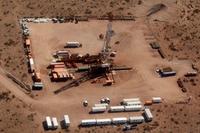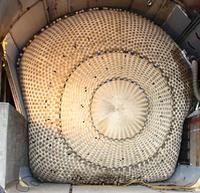-
Alternative to Keystone XL pipeline planned

The Obama administration rejected of the Keystone XL pipeline to carry Canadian oil to refineries on the U.S. Gulf coast, and now two companies are collaborating to develop an alternative plan to achieve the same end
-
-
Fusion presents low proliferation risk
American researchers have shown that prospective magnetic fusion power systems would pose a much lower risk of being used for the production of weapon-usable materials than nuclear fission reactors and their associated fuel cycle
-
-
New nuclear program to address U.K. capability gap
A joint project between the Universities of Manchester and Sheffield for a New Nuclear Build and Manufacturing (NNUMAN) program has been awarded £4 million funding by the Engineering and Physical Sciences Research Council to research innovative manufacturing for the future of the U.K. nuclear power supply
-
-
Water scarcity in California's Bay-Delta necessitates “hard decisions”

Simultaneously attaining a reliable water supply for California and protecting and rehabilitating its Bay-Delta ecosystem cannot be realized until better planning can identify how trade-offs between these two goals will be managed when water is limited
-
-
Containing a tunnel flood with an inflatable giant plug

Researchers have developed a giant plug to contain tunnel floods; the plug inflates (with water or air) to dimensions of roughly 32-feet-long and by 16-feet-wide, and holds 35,000 gallons, about the same capacity as a medium-sized backyard swimming pool
-
-
New laws help cut metal thefts

Metal thefts have become a plague to businesses throughout the country; some states pass laws which require licenses and permits to buy and sell non-ferrous metals; Spartanburg, South Carolina, also requires that buyers pay for the purchases with checks rather than cash, in order to create a paper trail to the seller of the metal
-
-
A swarm of small satellites to deflect menacing asteroids
New research suggests that the best way to divert an asteroid hurtling toward Earth is using a swarm of relatively small satellites flying in formation and cooperatively firing solar-powered lasers onto an asteroid; this would be a more effective way than the current methods being contemplated, which are focused on large unwieldy spacecraft
-
-
1930s technology to become 21st century tool against CO2 emissions
Human activity releases 30 billion tons of carbon dioxide into the air each year; a new approach to dealing with the problem has a back-to-the-future glint, leveraging technology that the petroleum industry has used since the 1930s to remove carbon dioxide and other impurities from natural gas
-
-
Dueling legislation over cybersecurity regulations
Attacks on U.S. critical infrastructure may bring about a Katrina-like situation: no electricity, no fresh water, limited traffic control, severely curtailed emergency response, and more; about 85 percent of U.S. critical infrastructure is privately owned; two different cybersecurity bills in Congress envision different solutions to U.S. infrastructure’s cyber vulnerability
-
-
Companies team up to develop carbon capturing
Three companies have teamed up to build a low-carbon, coal-based power plant in Scotland; the plant will include a carbon-capture and storage; with more than 90 percent carbon capture, the coal feedstock plant will generate extremely low-carbon electric power and also produce hydrogen gas for commercial use
-
-
The Transboundary Agreement is not just about the cost of gas and the environment
The Transboundary Agreement, which the United States and Mexico reached on 20 February, regulates oil and gas development in the Gulf of Mexico; before the agreement is ratified, there is a need to address serious security issues related to building more oil rigs in the Gulf – for example, the fact that the Mexican government cannot control its powerful criminal organizations, and that it will be easy for terrorists in a small boat to overrun one of these deepwater rigs
-
-
Electricity from trees
Plants have long been known as the lungs of the earth, but a new finding has found they may also play a role in electrifying the atmosphere; scientists found the positive and negative ion concentrations in the air were twice as high in heavily wooded areas than in open grassy areas, such as parks
-
-
Confirmed: oil from Deepwater Horizon disaster entered food chain
For months, crude oil gushed into the water at a rate of approximately 53,000 barrels per day; new study confirms that not only did oil affect the ecosystem in the Gulf during the blowout, but it was still entering the food web after the well was capped
-
-
New method for cleaning up nuclear waste
There are more than 436 nuclear power plants operating in thirty countries, and they create a lot of nuclear waste; one of the more toxic elements in that waste is radionuclide technetium (99Tc); approximately 305 metric tons of 99Tc were generated from nuclear reactors and weapons testing from 1943 through 2010
-
-
Simulation of nuclear fusion shows high-gain energy output
High-gain nuclear fusion could be achieved in a preheated cylindrical container immersed in strong magnetic fields, according to a series of computer simulations performed at Sandia National Laboratories; the method appears to be fifty times more efficient than using X-rays — a previous favorite at Sandia — to drive implosions of targeted materials to create fusion conditions
-
More headlines
The long view
Falling Space Debris: How High Is the Risk I'll Get Hit?
An International Space Station battery fell back to Earth and, luckily, splashed down harmlessly in the Atlantic. Should we have worried? Space debris reenters our atmosphere every week.
Using Drone Swarms to Fight Forest Fires
Forest fires are becoming increasingly catastrophic across the world, accelerated by climate change. Researchers are using multiple swarms of drones to tackle natural disasters like forest fires.
Strengthening the Grid’s ‘Backbone’ with Hydropower
Argonne-led studies investigate how hydropower could help add more clean energy to the grid, how it generates value as grids add more renewable energy, and how liner technology can improve hydropower efficiency.
LNG Exports Have Had No Impact on Domestic Energy Costs: Analysis
U.S. liquified natural gas (LNG) exports have not had any sustained and significant direct impact on U.S. natural gas prices and have, in fact, spurred production and productivity gains, which contribute to downward pressure on domestic prices.
